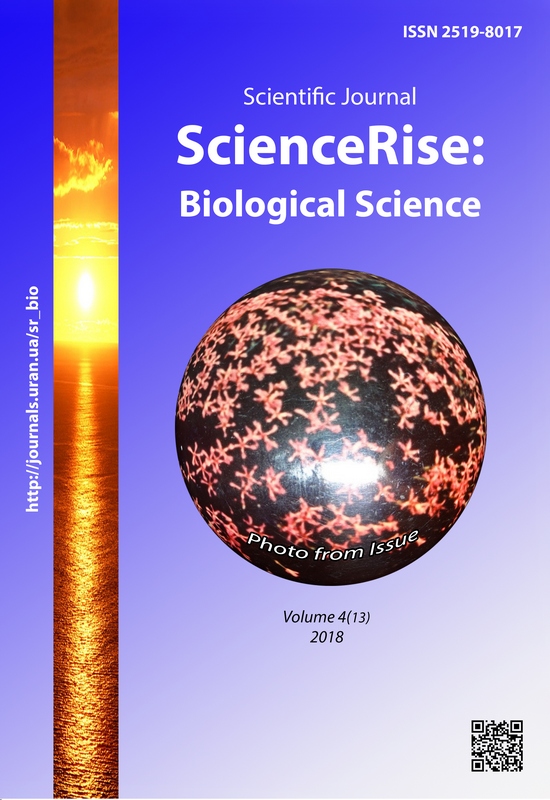Assessment of changes in the intestinal microbiome in the late debut of ulcerative colitis
DOI:
https://doi.org/10.15587/2519-8025.2018.141154Keywords:
ulcerative colitis, Firmicutes, Bacteroidetes, Actinobacteria, Faecalibacterium prausnitzii, Akkermansia muciniphilaAbstract
The aim of the study was to reveal the peculiarities of the intestinal microflora in patients with early and late debut of ulcerative colitis.
Methods of research: theoretical – analysis of scientific-methodical and special literature; experimental methods – collection of samples and DNA isolation, determination of oligonucleotide primers, polymerase chain reaction (PCR), determination of microbiom composition; mathematical - the method of average values.
Results: In the course of the study, it was determined that the number of Bacteroidetes in patients with late onset of UC development decreased in the Ukrainian population, and the level of Actinobacteria increased. Changes in the microbiota in patients with UC with different localization of the inflammatory process were analyzed. It is established that the composition of microbial types significantly differs not only depending on the age of onset of the disease, but also on the localization of the inflammatory process in the intestine. As the prevalence of UC increased, the level of Actinobacteria was highest in patients with left-sided bowel disease and late onset of UC. Whereas in patients with total intestinal lesion, both early and late development of the UC revealed a maximum decrease in Faecalibacterium prausnitzii.
Conclusion: UC patients experience intestinal dysbiosis. The level of Actinobacteria is increased in patients with late onset of UC development, and the number of Bacteroidetes decreases. In patients with early and late onset of the disease, multidirectional changes in the intestinal microbiome were detected, the number of Akkermansia muciniphila increased and Faecalibacterium prausnitzii decreased, which could lead to the development and progression of the disease. The ratio of Firmicutes / Bacteroidetes may be an additional marker for assessing the severity of intestinal dysbiosis in UC patients. At the same time, the prevalence of the pathological process in the intestine largely determines the therapeutic tactics and prognosis of patients with UC
References
- Li, J., Butcher, J., Mack, D., Stintzi, A. (2015). Functional Impacts of the Intestinal Microbiome in the Pathogenesis of Inflammatory Bowel Disease. Inflammatory Bowel Diseases, 21 (1), 139–153. doi: https://doi.org/10.1097/mib.0000000000000215
- Gomollón, F., Dignass, A., Annese, V., Tilg, H., Van Assche, G., Lindsay, J. O. (2016). 3rd European Evidence-based Consensus on the Diagnosis and Management of Crohn’s Disease 2016: Part 1: Diagnosis and Medical Management. Journal of Crohn’s and Colitis, 11 (1), 3–25. doi: https://doi.org/10.1093/ecco-jcc/jjw168
- Gerardi, V., Bruno, G., Petito, V., Scaldaferr, F. (2013). Inflammatory Bowel Diseases In: The Gut Microbiota The 4th organ of the Digestive System. Roma, 18–21.
- Scaldaferri, F., Fiocchi, C. (2007). Inflammatory bowel disease: Progress and current concepts of etiopathogenesis. Journal of Digestive Diseases, 8 (4), 171–178. doi: https://doi.org/10.1111/j.1751-2980.2007.00310.x
- Guinane, C. M., Cotter, P. D. (2013). Role of the gut microbiota in health and chronic gastrointestinal disease: understanding a hidden metabolic organ. Therapeutic Advances in Gastroenterology, 6 (4), 295–308. doi: https://doi.org/10.1177/1756283x13482996
- Moayyedi, P., Surette, M. G., Kim, P. T., Libertucci, J., Wolfe, M., Onischi, C. et. al. (2015). Fecal Microbiota Transplantation Induces Remission in Patients With Active Ulcerative Colitis in a Randomized Controlled Trial. Gastroenterology, 149 (1), 102–109.e6. doi: https://doi.org/10.1053/j.gastro.2015.04.001
- Joossens, M., Huys, G., Cnockaert, M., De Preter, V., Verbeke, K., Rutgeerts, P. et. al. (2011). Dysbiosis of the faecal microbiota in patients with Crohn's disease and their unaffected relatives. Gut, 60 (5), 631–637. doi: https://doi.org/10.1136/gut.2010.223263
- Vickers, A. D., Ainsworth, C., Mody, R., Bergman, A., Ling, C. S., Medjedovic, J., Smyth, M. (2016). Systematic Review with Network Meta-Analysis: Comparative Efficacy of Biologics in the Treatment of Moderately to Severely Active Ulcerative Colitis. PLOS ONE, 11 (10), e0165435. doi: https://doi.org/10.1371/journal.pone.0165435
- Zhang, B.-W., Li, M., Ma, L.-C., Wei, F.-W. (2006). A Widely Applicable Protocol for DNA Isolation from Fecal Samples. Biochemical Genetics, 44 (11-12), 494–503. doi: https://doi.org/10.1007/s10528-006-9050-1
- Prantera, C., Lochs, H., Grimaldi, M., Danese, S., Scribano, M. L., Gionchetti, P. (2012). Rifaximin-Extended Intestinal Release Induces Remission in Patients With Moderately Active Crohn's Disease. Gastroenterology, 142 (3), 473–481.e4. doi: https://doi.org/10.1053/j.gastro.2011.11.032
- Comito, D., Cascio, A., Romano, C. (2014). Microbiota biodiversity in inflammatory bowel disease. Italian Journal of Pediatrics, 40 (1), 32. doi: https://doi.org/10.1186/1824-7288-40-32
- Lewis, J. D., Ruemmele, F. M., Wu, G. D. (Eds.) (2014). Nutrition, Gut Microbiota and Immunity: Therapeutic targets for IBD. Basel, Karger. doi: https://doi.org/10.1159/isbn.978-3-318-02670-2
Downloads
Published
How to Cite
Issue
Section
License
Copyright (c) 2018 Anna Dorofeeva

This work is licensed under a Creative Commons Attribution 4.0 International License.
Our journal abides by the Creative Commons CC BY copyright rights and permissions for open access journals.
Authors, who are published in this journal, agree to the following conditions:
1. The authors reserve the right to authorship of the work and pass the first publication right of this work to the journal under the terms of a Creative Commons CC BY, which allows others to freely distribute the published research with the obligatory reference to the authors of the original work and the first publication of the work in this journal.
2. The authors have the right to conclude separate supplement agreements that relate to non-exclusive work distribution in the form in which it has been published by the journal (for example, to upload the work to the online storage of the journal or publish it as part of a monograph), provided that the reference to the first publication of the work in this journal is included.









